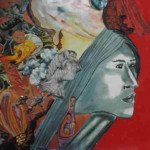California Institute of Integral Studies
EXA and Jung: The Symbolic Process Workshop
Instructor
Kate T. Donohue, Ph.D., REAT
Office hours by appointment
Private Practice Phone: 415-695-1464
Fax: 415-296-7425
Email: kate@katedonohue.com
DESCRIPTION OF COURSE CONTENT
A kinship naturally exists between expressive arts therapy and Jungian Psychology. Both are image-based approaches to understanding and healing the psyche and each emphasizes the symbolic process in its own unique fashion. This course weaves together the theory and practice of both these approaches into a Jungian-oriented EXA healing tapestry of images, emotions, understanding and transformation. The class explores the basic concepts of Jungian psychology and compares and contrasts them to EXA theory. Learning will be through experiential process, creative discussions, class reading and experiential and academically based assignments.
SUMMARY OF EDUCATIONAL PURPOSE
The purpose of this class is to learn through academic readings, experiential process and clinical applications the enhancement of EXA principles and practice through the interweaving of Jungian psychology concepts.
 KATE T. DONOHUE, Ph. D., REAT
KATE T. DONOHUE, Ph. D., REAT
Searching for meaning connects us to the soul and the spirit, resulting in a life that is more open, more joyful and closer to our true self.
My approach is guided by my passion for art, culture and spirituality. My work marries Jungian oriented expressive arts therapy with a search for what is real, authentic and unique within us.
Through the use of arts and personal expression we are able to access emotions in a deep and profound way, to heal trauma and to tap into the meaning and creativity of life.
I am a licensed psychologist and a registered expressive arts therapist (REAT). I hold a Ph.D. in Counseling Psychology and have maintained an active private practice for 33 years. I have also been teaching for 30 years, at such institutions as California Institute of Integral Studies, Institute for Transpersonal Psychology, JFK University and the San Francisco C.G. Jung Institute. I am a cofounder of the International Expressive Arts Therapy Association and a MCEP and CEU provider.
My work as an expressive arts therapist stems from my own deep and abiding passion for the arts. I am involved in visual arts and dance, having spent 18 years studying indigenous and ethnic dance forms, in particular West African and Afro-Cuban Dance. My visual arts work in painting and drawing has helped me explore an interest in understanding the sacred feminine. I have a background in drama and poetics, and a great appreciation for music. My involvement in arts and culture has made my own life richer, by allowing me to map and understand my own inner terrain.
LEARNING OBJECTIVES
Participants will:
- Experience Jungian oriented expressive arts therapy processes.
- Develop a theoretical understanding of Jungian psychology.
- Develop an understanding of the relationship of Jungian psychology and EXA.
- Explore the idea of cultural complex to address issues of diversity and cultural wounding.
- Understand and learn to apply Jungian concepts to EXA practices.
- Understand the symbolic process.
- Deepen their relationship to their own creative and symbolic processes.
- Learn about Jungian oriented EXA applications to their life and work.
LEARNING ACTIVITIES
- Cognitive: discussion, reading assignments, and clinical material 30%
- Experiential: personal process with the Jungian oriented EXA approaches 30%
- Practical: Dream art Journal, and written and arts based assignments 40%
CRITERIA FOR EVALUATION
GRADING: 0 Credit – P/F
Full attendance and participation are expected in order to complete this course.
REQUIRED READINGS
- Stein, M. Jung’s Map of the Soul: An Introduction. Chicago. Open Court Press.
- Chodorow, Joan. (1991). Dance therapy and depth psychology: The moving imagination. New York: Routledge.
- Donohue-Sohl Selected Readings
Strongly Suggested:
- Lewis, P. (1993). Creative Transformation: The Healing Power of the Arts.
- Jung. C. G (ed.) (1964). Man and His Symbols. London: Aldus Press.
- Jung, C.G., (1961) Memories Dreams and Reflections. New York: Random House.
- Young-Eisendrath, P. and Dawson, T. (eds.) (1997) Cambridge Companion to Jung. New York: Cambridge Press.
- Rosen, D. (1993). Transforming Depression: A Jungian Approach Using the Creative Arts. New York: A Jeremy Tarcher/Putnam Book.
- SCHAVERIEN, J. The Revealing Image. Analytical Art Psychotherapy in Theory and Practice.
DATES, LOCATIONS, THEME AND READINGS
Saturday and Sunday
1. Saturday morning:
Introduction to Marriage of EXA and Jung
- What is the symbolic process
- How EXA works/plays with images
- Focus on visual active imagination
- Introduction to the exploration of dreams,
- Introduction to the use of multi-arts images and the body in Jungian thought
All these concepts will be experienced in an arts process first and then discussed.
2. Saturday afternoon
Opening Process: Demonstrate how to explore a dream through the body and senses
- Introduction using somatic and kinesthetic imagery to the affects/emotions and affect images
- Expanded view of Libidinal energies the personal, cultural and collective unconscious
These processes will help us learn about and discuss archetypes, personal, cultural and collective symbolic function.
3.Sunday morning
Opening Process: Demonstrate how to explore a dream
- Exploration of primitive identity, and the self
- the development of ego conscious
- the ego-self axis
1. Sunday afternoon:
Opening Process: Demonstrate how to explore a dream
- Exploration of Jung’s complex theory
- The dimensions of complexes
- How they manifest and serve us
- How to explore them through EXA
- Exploration of another aspect of complexes,
- Cultural complexes
- How they aid in exploring culture and cultural wounding as well as diversity
- Applications for social justice
Suggested Reading
Chodorow, J. . (Ed.). (1997). Jung on active imagination. Princeton, N.J.:
Princeton University Press.
Johnson, D. H. & I. J. Grand (Eds.), The Body in Psychotherapy. North
Atlantic Books and The California Institute of Integral Studies.
Knill, P.J., Barba, H.N. and Fuchs, M. N. (1995) Minstrels of Soul: Intermodal Expressive Arts Therapy. Toronto, Ontario, Canada: Palmerston Press.
Levine, E. & S. (eds.), (1999) Foundations of Expressive Arts Therapy. Philadelphia, PA. Jessica Kingsley.
Lewis, P. (1993). Creative Transformation: The Healing Power of the Arts. Wilmette, Illinois: Chiron Press.
Lusebrink, V.B. (1990) Imagery and Visual Expression in Therapy. New York: Plenum Press.
McNiff, S. (1992). Art As Medicine. Boston: Shambhala Press.
McNiff, S, (1987). The Arts and Psychotherapy. Springfield, Illinois: Charles, C. Thomas.
Pallaro, Patrizia. (Ed.), (1999). Authentic movement: Essays by Mary
Starks Whitehouse, Janet Adler, and Joan Chodorow. London: Jessica Kingsley
Publishers.
Robbins. A. (1994). A Multi-Modal Approach to Creative Art Therapy. Bristol, PA: Jessica Kingsley Publishers.
Robbins, A. (ed.) (1998). Therapeutic Presence: Bridging Expression and Form. Philadelphia, PA. Jessica Kingsley Press.
Schwartz-Salant, Nathan & Murray Stein (Eds.),(1999). The body in analysis.
Wilmette, Illinois: Chiron Publications.
Schwartz-Salant, N. and Stein, S. (1995). Transference and Countertransference. Wilmette Press: Chiron Press.
Stein, M. (1995). Jungian Analysis. London: Open Court (second edition).
Stein, M (ed.), The Interactive Field in Analysis. Wilmette, Illinois: Chiron Press.








